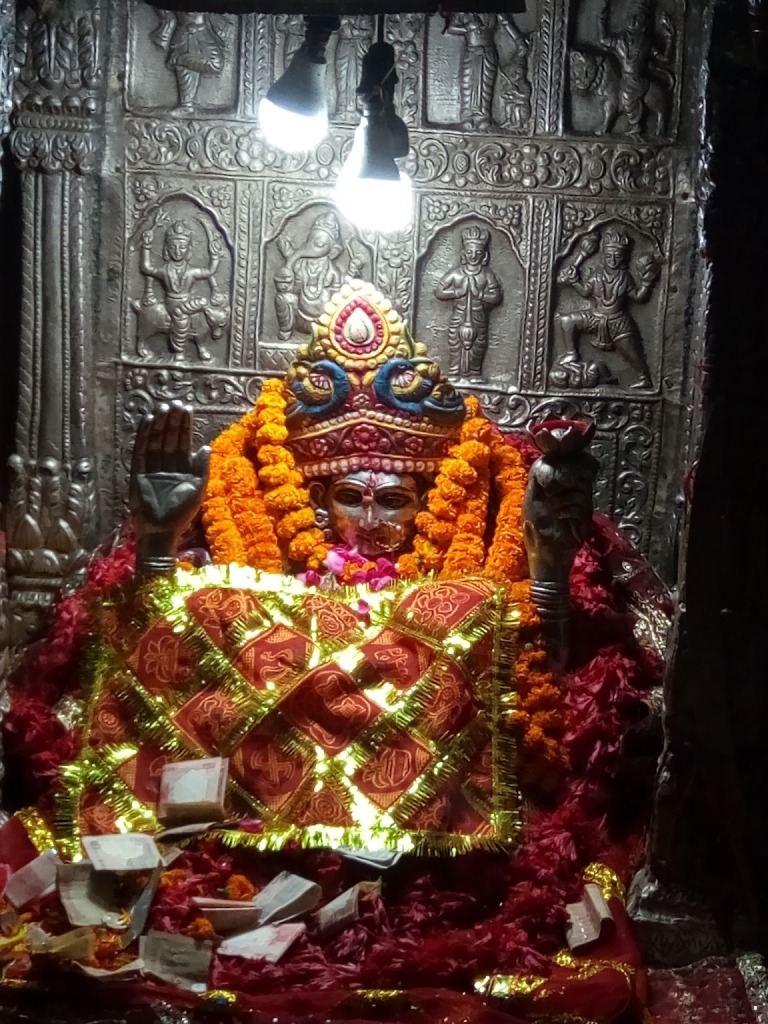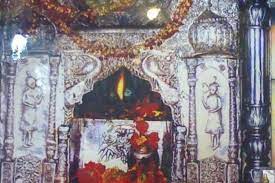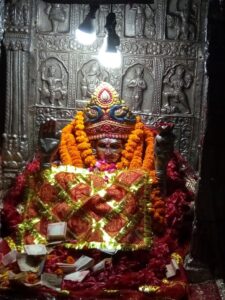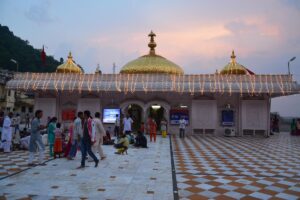Jwalamukhi Temple Himachal Pradesh
Jawalamukhi, also known as Jwalamukhi or Jawalaji, is a temple village and nagar parishad in Kangra district, Himachal Pradesh, India. The community gets its name from the sacred Jwalamukhi Temple in Jawalamukhi.The temple is a well-known shrine to the deity Jwalamukhi, who is thought to be an incarnation of Adi Parashakti, also known as Durga or Kali. One of the 51 Shakti Peethas, the shrine is revered.
Jwalamukhi Temple History:
According to legend, the ruling king, Raja Bhumi Chand, Katoch of Kangra, a great devotee of the goddess Durga, dreamed of the sacred site and sent people to locate it. The Raja traced the spot and built a temple there. The current shrine features a gold-gilded dome, numerous pinnacles, and a silver entry door. The Dhauladhar mountain chain contains the temple. Jwalamukhi mata is worshipped as an eternal flame that appears from a tiny fissure in a rock within the sanctum sanctorum. The shrine is said to be dedicated to the Navadurgas, who are represented by nine fires.
It is unclear how long the flames have been burning and where they came from. Scientists anticipated that beneath the temple is an underground volcano whose natural gas burns through the rock as the flames. Fearing that the fire would burn down the town, Akbar, the former emperor of the Mughal empire, attempted to extinguish the flames by covering them with an iron disc and even splashing water on them. But the flames annihilated all of our attempts. Akbar then gifted the shrine with a golden parasol (chhatri). Thousands of pilgrims visit the sanctuary every year to fulfil their spiritual needs.
Every year, hundreds of thousands of pilgrims visit the temple, which is situated on a small spur on the Dharamshala-Shimla road about 20 kilometres from the Jawalamukhi Road Railway Station. In front of the shrine, there is a tiny platform and a large mandapa where the King of Nepal has hung a huge brass bell. Typically, milk and water are given to the deity, and abhisheka is offered to the pit’s sacred flames.
The deity’s prasada is Bhog, which is composed of Rabri or thickened milk, Misri or candy, seasonal fruits, and milk. In front of the flame is a Sri Yantra, which is adorned with shawls and decorations. The ritual has several ‘phases’ and lasts almost the entire day. Aarti is done five times a day, havan once a day, and parts of Durga Saptasati are recited.
Maharaja Ranjit Singh visited the sanctuary in 1815 and had the temple’s dome gold-plated. A six-foot-deep pit with a three-foot circumference exists just a few feet above the Jwalamukhi shrine. There is another tiny pit about one and a half feet deep at the bottom of this pit, with hot water bubbling all the time.
The shrine has been designated as one of the 51 Shakti Peethas. It is also one of the most well-known shrines dedicated to Goddess Durga.
Story behind the Jwalamukhi Temple:
The sanctuary is considered a Shakti Peetha. Sati’s tongue is said to have fallen here. Shakti Peethas are Adi Parashakti, the primordial Mother Goddess, sanctuaries. Each Shakti Peetha has a shrine dedicated to Shakti and Bhairava, a manifestation of Shiva and Shakti’s consort. Jwalamukhi is the Shakti in this case, and Unmatta Bhairava is the Bhaira. The Daksha yaga and Sati’s self-immolation were monumental in shaping ancient Sanskrit literature and even had an influence on Indian culture.It resulted in the development of the idea of Shakti Peethas, which strengthened Shaktism. Massive stories in puranas attribute the Daksha Yagna to its genesis. It is a significant event in Shaivism because it resulted in the emergence of Parvati as Sati’s reincarnation, and by marrying Shiva and giving birth to Ganesha and Kartikeya, Shiva became a grihastha. (householder).
Jwalamukhi temple timings:
Aartis are mandatory rituals in all temples across the nation. Pujaris execute five Aartis in worship of the Goddess.One aarti is done in the early morning, one at sunrise, one at midday, one in the evening, and one at the Goddess’s bedtime. The Aartis and Jwala Devi Temple Timings are as follows:
Summer:
Temple Opening Time – 5 AM
Mangal Arti – 5 AM-6 AM
Bhog Arti – 11:30 AM-12:30 PM
Evening Arti – 7 PM-8 PM
Shaiyan Arti – 9:30 PM-10 PM
Temple Closing Time – 10 PM
Winter:
Temple Opening Time – 6 AM
Mangal Arti – 6 AM – 7AM
Bhog Arti – 11:30 AM-12:30 PM
Evening Arti – 6 PM – 7 PM
Shaiyan Arti – 8:30 PM – 9 PM
Temple Closing Time – 9 PM
Jwalamukhi Temple Location:
Sri Jwalamukhi Temple, Kangra, Himachal Pradesh
How to reach Jwalamukhi Temple:
By Air: The closest airport is in Guggal, about 46 kilometres from the Jwalamukhi temple. Indian Airlines runs three flights per week from Delhi to Dharamshala.
By Rail: The closest railway station is Pathankot, which is approximately 123 kilometres away. Outside the station, buses and taxis are accessible.
By Bus: Regular buses run from Pathankot to the Jwalamukhi shrine.
Jwalamukhi Temple Distance:
jwalamukhi temple to dharamshala distance – 1 hr 31 min (51.5 km) via NH303 and NH503
Pathankot to Jwala Devi distance by road – 2 hr 56 min (110.5 km) via NH154 and State Hwy 23
Jwalamukhi Temple Photos:




